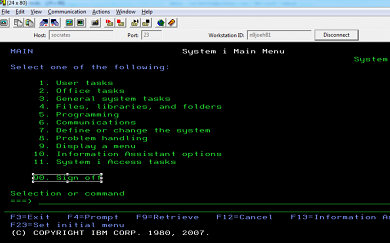Software makes work efficient. Let’s divert those savings.
 Editor’s note: This is the sixth in a multi-part series on the budget for the State of Oregon and where possible efficiencies can be found.
Editor’s note: This is the sixth in a multi-part series on the budget for the State of Oregon and where possible efficiencies can be found.
If you've ever attended -- either in person or by video -- a meeting of the Joint Legislative Committee on Information Management and Technology, also known as the IT Committee, you've seen a familiar refrain. Whether in the early stages of asking for approval, or the later stages of reporting progress, agencies doing IT projects consistently, predictably bemoan their existing systems, heavily using the terms "COBOL", "green screen" and "mainframe". And, while they paint a dire picture of the current state, they simultaneously paint a rosy picture of how a new software system will make their agency much more efficent, productive and provide better service to the taxpayer.
Perhaps it's time we take them at their word.
These IT projects are tremendously expensive -- from the more modest ones costing tens of millions of dollars to perhaps the largest fiscal fiasco in the history of the state, Cover Oregon, which cost the taxpayers over $300 million dollars, without ever releasing a finished product. Currently, these projects are often funded with general fund money and the cost savings, efficiency and productivity promised years earlier seem to just get swallowed up in the biennial budget churn. In the end if there were any savings, they never made it out of the agency.
Here's a simple thought: What if we made every agency pay for their software project by returning the value created by the software project to the general fund. In a sense, the state would be just loaning the value to the agency. Here's how it would work:
Let's say an agency wants to embark on a $30 million software project -- a medium sized endeavor that the agency claims will make them more efficient. The legislature will loan the agency the $30 million and have it paid back over, say, a period of 15 years at the cost of $2 million per year. The Legislative Fiscal Office estimates that the cost of sustaining an employee for a year is about $125,000, which includes salary, benefits, retirement and infrastructure. That means once the software is released, they have to agree to lower their head count by 8 people (8 x $125,000 = $2 million).
There are two basic ways to draft a government budget. Budgets can be done as a current-service-level baseline budget, where the same money as the last fiscal period is allocated plus increases for inflation, plus increases for population increase, plus any possible increases for program expansion. Alternately, budgets can be done as a zero-based budget where the entire budget from previous fiscal periods are not considered and a new budget is built from scratch. As attractive as zero-based budgeting sounds, it's not possible or practical to do all the time, so Oregon has adopted a hybrid system. The savings can easily be programmed into the current service level for the agency.
The savings would be twofold. First, there would be a way to pull the savings out of the agency and back into the general fund where they can be more carefully allocated. Second, it might make agencies think twice about how badly they want to undertake an IT project and what the
actual savings might be.
One caveat: Sometimes the rationale for doing an IT project is something like compliance or increased security and there is no financial return. In these cases, the legislature could write new key performance measures to reflect outcomes based on these requirements, and forego some or all of the fiscal return. That could be the choice of the legislature and it doesn't create a problem.
Additionally, it could be argued that since only the legislature has the constitutional authority to allocate money, it's not legal for the agency to realize savings from a software project and redirect those savings back into agency programs. Any savings
must be directed back into the general fund.
As said earlier, IT projects are very expensive. The savings that could be realized by this discipline could also be very large.
Savings: Tens of Millions, each biennium
--Staff Reports| Post Date: 2020-07-16 08:00:00 | Last Update: 2020-07-06 22:24:34 |







 Editor’s note: This is the sixth in a multi-part series on the budget for the State of Oregon and where possible efficiencies can be found.
Editor’s note: This is the sixth in a multi-part series on the budget for the State of Oregon and where possible efficiencies can be found.